The Desert War: Gaming WW2 in North Africa Part Five – Endgame
September 14, 2015 by crew
At last we come to the end of our Desert War article series, taking a look at the final battles of World War II North Africa through the eyes of 15mm Battlegroup. For those just joining us, check out our progress so far in Parts One, Two, Three, and Four. But for now let’s see how this epic campaign finally drew to a close, and how some of these final engagements can be brought to the tabletop.
Wounded But Deadly
After the Allied victory at El Alamein (Oct-Nov 1942), the shattered remnants of Rommel’s “Panzerarmee Afrika” rapidly fell back out of Egypt, through Libya, and all the way to the Vichy French colony of Tunisia. Part of the reason for such a long retreat was “Operation Torch,” where an entire Anglo-American army had simultaneously landed a thousand miles behind the Germans and Italians on November 8, 1942.
The idea was not only to squeeze the Axis off of the continent of Africa for good, but to partly assuage Stalin’s protests for a “Second Front” and to finally get American ground forces in action as soon as possible. There would be plenty of other political ramifications, especially with the French forces that still ran these colonies under the Vichy government.
It was these initial American landings in Morocco which formed the focus for our next Battlegroup game. After all, anyone who’s seen the movie “Patton” knows about the American disasters at Kasserine Pass and subsequent redemption at El Guettar. Bsides, who hasn't seen enough “American vs. German” in miniature battles?
Port Lyautey
So instead we decided to take a look at an engagement that took place near Port Lyautey, where the northern wing of General Patton’s “Western Task Force” had come ashore. Regrettably, despite earnest efforts by Allied agents and diplomats before the invasion, Vichy French forces actually fought hard against the invading Americans.
The idea of two Allied nations in pitched (and bloody) battle for several days sounds strange, but sadly, it happened.
The politics here are complex. When France had to surrender to Germany in June 1940, a puppet government in the French city of Vichy was allowed to remain “autonomous,” which technically made this “Vichy government” (and its French colonies) an Axis power. By and large, French soldiers in these colonies never voluntarily took part in Germany’s battles, despite the status of their “official” government from which any army takes it orders.
However, whenever Great Britain invaded a Vichy colony like Lebanon or Madagascar, fighting was always fierce. Vichy French troops even fought against Free French troops in Syria. Far from any sense of “Axis loyalty,” this was more of a case of troops obeying official orders, combined with a simple case of “get your tanks off my lawn.”
When the Americans came ashore in Morocco, they too would learn this...the hard way.
Raw, inexperienced, and perhaps over-anxious to finally “show the Europeans how to fight,” the Americans struggled with the complexities and dangers of an amphibious invasion. Then they struggled with the Vichy garrison, which did NOT give up or immediately re-join the Allied cause, despite earnest diplomatic efforts beforehand.
Casualties were heavy, especially in the northernmost American landings at Port Lyautey, where we decided to stage out ninth Desert War game. Here, a force of French armour drove north to counterattack the flank of the Port Lyautey landing zone, and American tanks had to hold them back.
Desperately outnumbered, the American tanks fought furiously. But they probably survived thanks only to the 6-inch guns of light cruiser USS Savannah, and US Navy torpedo bombers dropping antisubmarine depth charges (of all things) on French tanks and artillery positions.
After three or four days, frantic diplomatic efforts finally paid off and the French were convinced to re-join the Allied cause. Fighting sizzled out and together the British and Americans (along with plenty of Free and formerly-Vichy French) pushed hard to the east, out of Morocco and Algeria, and to the final Axis hold out in Africa. Tunisia.
This last enclave wouldn’t fall for six months, after some of the worst fighting in the North African war.
A New Battlefield
The battlefields of Tunisia presented a very different type of desert from the classic “sand seas” of Libya and Egypt. Here there was thicker vegetation, more towns, and considerable rain in the winter. In fact, this December quagmire of mud is one reason the Allies couldn’t swoop in and claim Tunisia right after Torch and El Alamein.
This desert was also much rockier and more mountainous, resulting in deadly battles over narrow defiles and passes. Such was the case at Sidi Bou Zid and Kasserine Pass, where raw American troops ran head-long into battle-hardened German panzers for the first time.
Both these February 1943 encounters were unmitigated disasters for the Americans, and for a while it seemed as if the Germans might stage yet another comeback.
Montgomery’s Eight Army, meanwhile, was trying to rush through Rommel’s defensive line, roughly along the Tunisia-Libyan border. This was the so-called “Mareth Line,” a system of old French fortifications built in the 1930s. But our friends, the Long Range Desert Group (LRDG), found a way through the Tunisian mountains (the Tebaga Gap) that allowed Monty to partially outflank this line, which quickly crumbled.
Meanwhile, the famous General George S. Patton had taken over the US II Corps, which had just been handed such ignominious defeat at Kasserine Pass. With a mix of reorganization, motivation, and hard discipline, he was able to put these divisions back together, which eventually met and wrecked a German attack at El Guettar in March.
The battle didn’t go perfectly, and despite what we see in the movies, Patton wasn’t present until after the issue had been decided. Even so, it can’t be denied that the vast improvement in American performance and confidence is testament to Patton’s leadership, training, and inspiration of II Corps.
The British, meanwhile, had also broken through in the south. Pushing up through Tunisian towns like Enfidaville and Gabes, they soon linked arms with the British, French, and Americans closing from the west.
The remnants of Heersgruppe Afrika collapsed around the so-called “Bizerte Bridgehead,” repeatedly denied permission to make any kind of withdrawal from what was clearly a hopeless position.
One of the last engagements along this shrinking perimeter, however, has held special meaning to historians, armour enthusiasts, and wargamers. On April 21, 1943, the Germans scraped together some armour from the “Hermann Göring” and 10th Panzer Divisions to make a last-ditch spoiling attack near Madjez el Bab.
This is the battle we tried to recreate in our last Desert War game.
A Final Strike
Or course, the counterattack was beaten back. Among the losses was the soon-to-be famous Tiger 131, the first Tiger captured by the British. The Tiger was inspected by Churchill and King George VI, before being stripped apart for study by British technicians. It would be almost 70 years before the tank was put back together again...
By the end of April 1943, the rest of Axis forces bottled up in Tunisia were faring little better than Tiger 131. By the middle of May, it was all over. Only about 600 Germans or Italians ever escaped Tunisia. Some 250,000 others (two complete armies) had either been killed or taken prisoner in the final collapse, a defeat equal to Stalingrad just three months before.
The war in Africa was, at last, over.
The Allies, meanwhile, had forged an alliance ready to undertake the invasion of Fortress Europe. The British had won a great victory and at last had a hero. The Americans had been blooded and learned the practicalities of mobile warfare with startling speed.
The French had been brought back into the fold, no longer side-lined by the enforced neutrality of the Vichy Regime.
And so at last, our “Desert War: Gaming WW2 in North Africa” article series comes to a close. Once again I’d really like to thank Beasts of War for the opportunity to publish on their site. Also, I offer sincere gratitude to my editor @brennon for his understanding and patience, especially as I send him wave after wave of drafts and revisions.
Most of all, I’d like to thank the readers who’ve slogged through my walls of text, and kept the conversations going with such positive, constructive, and insightful comments. Until next time, everyone, happy desert gaming! Keep a full canteen and watch out for those sandstorms!
If you would like to write an article for Beasts of War then please contact me at [email protected] for more information!
"The idea of two Allied nations in pitched (and bloody) battle for several days sounds strange, but sadly, it happened..."
Supported by (Turn Off)
Supported by (Turn Off)
"The battlefields of Tunisia presented a very different type of desert from the classic “sand seas” of Libya and Egypt..."
Supported by (Turn Off)










































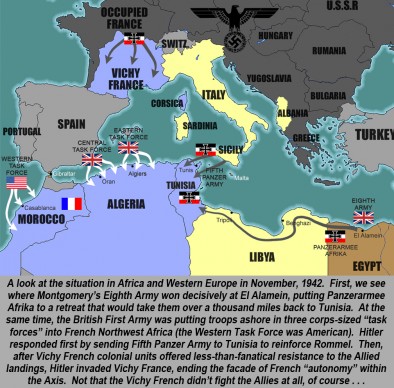
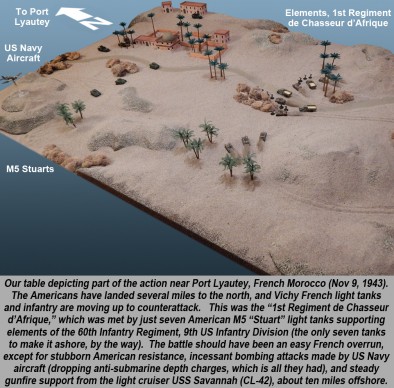
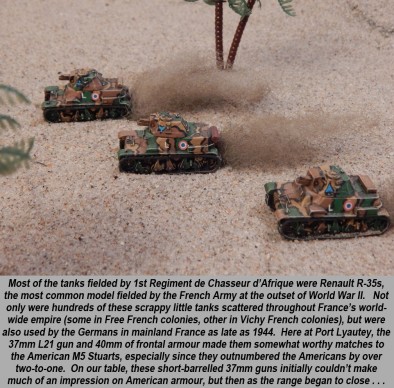




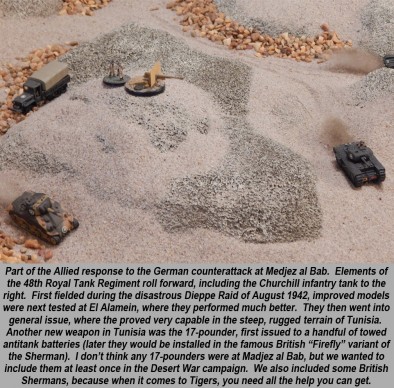
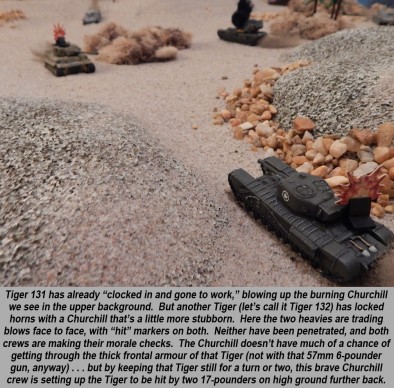
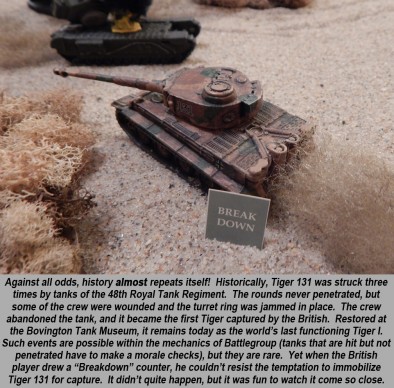
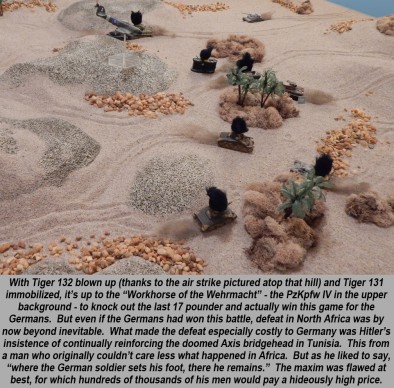


































Very nice! Great to see you included the Vichy French battles, it is indeed a forgotten piece of history. Cool, that 131 broke down 😀
“… not nearly the beginning of the end.” Hopefully we’ll be seeing a lot more article series from you Oriskany! Some theatres that would be awesome (and are less know or iconic); Burma, China 37-45, Yugoslavia, Continuation War, Kourland Peninsula, Battle of the Atlantic (yay naval wargaming!), Hungary 45,…
Thanks, @neves1789 . Although you realize you laid out seven more article series . . .
That’s about another year’s worth of work!!
I’m glad you liked the Vichy battles. I was a little worried about skipping the more famous engagements like Kasserine, but I thought it best to take the road less traveled.
Thanks again!
I realize that all too well but the people demand it! We demand it! 😀 (in other words, excellent work you’re doing 😉 )
Skipping Kasserine didn’t feel like an omission at all, I’ve found the historic significance of that battle to be overrated anyway. The Vichy resistance is much more interesting from political and gaming point of view.
In many ways I agree about Kasserine, @neves1789 . Although it is interesting to look at from the right perspective. When Brian Train produced “Desert Leader” (desert-themed expansion of Panzer Leader in 2000), he presented a great scenario for Sidi Bou Zid that went out of its way to show just how unprepared the US Army was at first, especially for combat against veterans 10th and 21st Panzer Divisions (they had to make up a new “morale” cohesion level to show how green the Americans actually were). A week later came Kasserine (some people consider these two engagements different parts… Read more »
I think with Kasserine the most important lesson learnt was by the Americans and how awful their AT guns were
I have to totally agree with that one. I think this is brought most to focus by the so-called American “tank destroyers” of this period, which was often a 37mm antitank gun bolted on the top of a M3 halftrack. It’s amazing how the Americans thought this could punch holes in late-model Mark IVs. Fortunately, the quickly resolved the issue, as we see with the 899th Tank Destroyer Battalion making such a huge difference at El Guettar. These M10 Wolverines came in and really did a number against the left wing of 10th Panzer’s spearhead. Given that the El Guettar… Read more »
Well you could argue that the defeat at the start of the US N.African campaign was important as I would hate to think what would have happened if they had straight to Italy with the troops and equipment they had when they landed in Africa
Can’t argue with that, @torros . I’ve heard some people call North Africa, especially for the Americans, a “practice war.” — Now I don’t know if I agree with that 100% (I’m sure it didn’t feel like “practice” to the men who were there), but it can’t be denied that many levels of American leadership were a little TOO anxious to get straight into the thick of it without pausing to learn from everyone else’s mistakes and what had actually been going on for the last three years. This is on all levels, too. Not only were tobacco-spittin’ “strappin’ young… Read more »
The same thing happened with the American troops in 1917. Bravely just went straight in like it was 1915 all over again for the other allies and got a terrible mauling.
Certainly. I guess no one “likes” top go to war, but our geographical position usually gives us the luxury of postponing entry into a lot of wars, only finally jumping in when we have no choice. Some historians look down on American history for that (I’m not one of them, again, who WANTS to go to war), but what’s odd is how the American officer corps doesn’t look at what’s been going on there already, or take the opportunity to learn from other people’s mistakes. As you say, the American entry in WWI in 1917 was bloody like the other… Read more »
Pardon me while I wipe away a tear… It’s sad to see this series end. The desert war has become my favorite theatre of WWII. For the next series I vote again for Norway. Lots of really interesting stuff there including the nazi nuclear program connection.
I’m all for Norway! No sand in the dining room 🙂
How would you stop the snow from melting?
Puddles are much easier to clean than sand. Besides our balmy 92 degree 95% humidity weather means we keep our a/c low enough that the snow might not melt 🙂
I suppose you could always blame any puddles on Oriskany’s excitement at playing new game
We could always use baking soda or flour or sugar . . . no danger of making a mess there. 😀
I think you’ll end up with A bit of MDF painted white
Thanks, @koraski . Indeed the Desert War is one of my favorite spots. When you’re playing there and everyone else is in Normandy or Market Garden or Bulge or Stalingrad . . . they’re looking at your like: “does he know something we don’t?” 🙂 I agree about Norway, too . . . but I think one of our Bolt Action experts has to jump on that one. This would be especially true if you wanted to explore the German “heavy water” production for their so-called nuclear weapons program. This was Norwegian Resistance / British SOE (Special Operations Executive), if… Read more »
True operation Weserübung would be better played on a tactical level than on a divisional level
Agreed, like we were saying before, I think either very “large” (operational level with full involvement of naval and air forces) or very “small” (i.e., Bolt Action firefights). Anything in the middle I fear would get a little “soggy” from a design perspective, if that makes sense. But of course I haven’t tried it . . . 🙂
I love seeing these for the first time on the sight. I must say, I think your opening picture is a perfect choice. Stairing down the barrel of a Tiger brings weight and meaning to “the end” and can almost be seen as a threat “read the rest of this series or else!”
Another great job Ork-shany ;p I hope Warren projects let you get time in for your next series!
@oriskany Did you see the message I sent?
Indeed i did, @torros . Thanks! I gotta say, in addition to the divisional wargame, the 1939-41 naval game also looks great. Larry Bond came out with a great WW2 naval wargame (“Command at Sea” I think) but typical Larry Bond (helped Tom Clancy write Hunt for Red October and wrote the “Harpoon” wargame) – it is silly complicated. As for the divisional game, it looks like each piece is roughly a battalion? USSR Rifle Division 1941 (Poor) *** HQ, 9 x Infantry, 3 x Artillery, 1 x Engineer USSR Armoured Division 1941 (Poor) *** HQ, 1 Recon, 3 Light… Read more »
Yeah each stand is a battalion and I think each square is 1km, though I think you could play it without squares
@oriskany Awesome job on the whole series! Thanks to you, everytime I browse books on the Second World War I’m looking for Africa. Hmmm, got myself Rommel’s Tanks which is a monography of the DAK and beyond.
Rommel’s tanks . . . you’re not talking about the little “Metagames” box, yellow in color, I think . . .
https://boardgamegeek.com/boardgame/4139/rommels-panzers
. . . or are you talking about something else? Video / computer game?
I remember that
Right, @torros ? I actually have it in my closet somewhere. Haven’t played it in 20 years . . . but I technically still have it.
I think I played it once or twice..can’t remember much about it. I recognised the cover to be honest
Nah, I don’t have access to it here in Poland. Remember we were on the wrong side of the curtain and such things from the 70’s are almost like artefacts to buy now. Check your PMs.
Aha! Thank you, @yavasa ! I have it. I will have to see if I can find my old Rommel’s Panzers from my closet. I rmmeber the came cost one whole dollar from a gaming store in Orlando, the whole game can basically fit in a cargo pants pocket so it can’t be too complex. Although, anything in MY closet, from THAT far back? I will have to make sure I have the Eye of Ra stone set into a staff of the correct length so the sun will strike it and direct a red beam to the right point… Read more »
I would suggest the good ol’ “Open sesame”! for starters @oriskany only then use the staff. 😀
You haven’t seen my closet. 😐
Take him seriously fellow gamers…his closet beats mine for amount of stuff, and that’s me including my shoes and purses. Think more warehouse at the end of Indian Jones rather than well of souls. Even snakes wouldn’t survive in there.
Hmmmm it is surprising. I remember @oriskany writing he was in logistics while in the Corps. 😉
Never assume a military warehouse is organized, @yavasa . 😀 Anyway, I finally found it (at the bottom of the thread). Heading home from work now to see about playing a game. The counter sheets had never been punched! A 37-year old wargame will be played for the first time tonight!
Is Rommels Panzers the same scale and production value games as One page Bulge?
Rommel’s Panzers might be even smaller / less prod value. The company was “Metagaming,” published 1978, and like I said, you could literally fit it into a baggy pants pocket. The “emptiness of the desert” was an excuse to use a mapsheet that was basically a blank hex grid. 🙂
Looks similar in style to the Steve Jackson game
Look that way. I’m not familiar with the One-Page Bulge game, though. I used to have some other of Steve Jackson’s little box games, though, like freakin’ O.G.R.E. Gawd, remember that beast?
well that was a good end to the run I think you may have mentioned tiger 131 on other posts Lol.
She’s a famous lady! A bonafide one-of-a-kind movie star . . . literally. 😀
I can easily say see you next time mate! I BET ITS JUST THE BEGINNING OF YOUR ARTICLES! THANK YOU!
Thanks very much, @radegast – although te-e-e-echnically, I’m afraid you would “lose” that bet. This is far from the beginning of my articles, it’s actually the seventh series I’d done with Beasts of War: 1) The Four Levels of Wargaming 2) The “Other” World War 2 – Gaming in the Pacific 3) Making the Game Your Own – Star War Pocket Models 4) Battle of the Bulge – 70th Anniversary Commemorative Campaign 5) World War 2.5 – Gaming an Alternative History 6) The Worldwide D-Day Challenge (WWDDC) 7) The Desert War, Gaming in North Africa A few things are swirling… Read more »
Hmm… It would be interesting to see how someone so meticulous would approach SF gaming… Not that I want to see you reduce your WWII output, but a futuristic spinoff would be interesting @oriskany !
Thanks, @angelicdespot . Always appreciate such supportive feedback! 😀 I’ve done the Star Wars series, which I guess was **sort of** sci-fi (some sci-fi die hards probably consider it more “space opera” or “space fantasy”). Anyway, that series and wargame was moderately successful compared to some of the others.
But I agree 100%, I definitely want to change gears from WW2 for at least one article series.
I thoroughly enjoyed this series. Thank you so much for putting in all the time and effort to give us such an informative and inspiring set of articles. Now where is my desert yellow undercoat spray?
Thanks so much, @hengest . Good luck finding your yellow paint. Always keep your canteen full, don’t forget your sun compass, and watch out for those sandstorms! 😀
Do you have the pieces to make a Korean War series? Lot of interesting battles that aren’t well known. Which is a facet of what made this Desert series so much fun.
Actually I’ve always wanted to do a Korean campaign. And I do have lots of Shermans, three M26 Shermans, and of course T-34/85s. I probably COULD do it, with a few more miniatures and of course some new terrain. I’d need some of those very early choppers from M*A*S*H . . .
“Attention, 4077th! Incoming wounded!”
Complete with a MASH unit? 🙂
I totally have the jeeps, @rasmus , along with trucks, larger trucks, and even the medical tents (.pdf building downloads from David Graffam Models). 🙂 All I would need are those tiny helicopters they used to have. Maybe have to re-paint a few of my officers with fishing hats and Hawaiian shirts. 😀
Thanks for this series Oriskany, It was informative and I learned quite a bit!
Awesome, @ghostbear ! Thanks very much, I’m glad you liked it. 😀
Well I tried to resist but its time to put in an order to fighting 15’s and get some lovely 3mm tanks and stuff to replay The Western Desert
Against all odds, I found my “Rommel’s Panzers” box last night in my closet. Reading rules, I hope to solitaire a game tonight after work. 😀
That’s nostalgia, baby. Just drink it in. 😀
A fantastic finale @oriskany ! 🙂
Thanks you, sir. 😀
Thanks for this series, it was a really enjoyable read all the way through and look forward to more 🙂
Thanks, @hobbitovdoom . 🙂
Really great articles. I enjoyed each one. Thanks for sharing and all the hard work.
The tables and minis looked great. I cannot wait to play Battlegroup. I just need some players in my area.
Thanks, @cbrenner . I hope you find some local players. Battlegroup is indeed a great system, and while you can play it “solitaire” to get used to the rules, playtest scenarios, etc . . . it REALLY comes into its own in “live” head-to-head play. Those Battle Rating Counters, never knowing exactly when your “army” will break, and definitely not knowing how close the enemy is to really breaking (counters are kept hidden), all add just the right amount of fog of war and randomness . . . not too much like Combat Commander and some other games.
Wow, what a great end to a superb series @oriskany !
After an enforced break I’ve just been able to plough through parts 3, 4 & 5 and what an interesting series it was! And the photos of the battles really did get better and better.
Looking forward to reading whatever you do next!
Definitely great to hear from you again, @angelicdespot . I hope whatever was keeping you away during your “enforced break” has been sorted. Yeah, those tables in Part One were pretty sad. The sand tables were kind of a pain to work with in the house but worth it, both for game play and for article photos. I’ll probably post the last photos from this project in the “Additional Maps, Photo, Discussion” thread today, finally closing this out. As for what’s next, there are a couple of candidates, but probably not WW2. Possibly something modern? 🙂
Congratulations on another great series @oriskany. You writing style and the format you use are fully matured and at a very high standard of brilliance. I re-read this series a couple of times with the question in mind what makes it so outstanding. I picked up a book on the Lorraine campaign and then it struck me. You gave us a historical overview of the entire campaign including eastern Africa that so many big name historians leave out. You clearly showed us how the armies had to evolve and the hardships and troubles faced by both sides. You gave us… Read more »
Wow, @jamesevans140 . If I ever get a novel published you’re the guy writing the dust cover. 🙂 Seriously, very kind words, thanks very much.
Not sure what the next one will be. Of course BoW approves everything first. Maybe something outside of World War II. 🙂
Again, thanks for the great review!
Your more than welcome @oriskany, you earned it.
😀